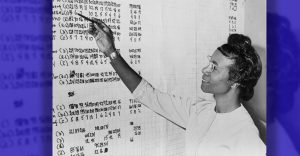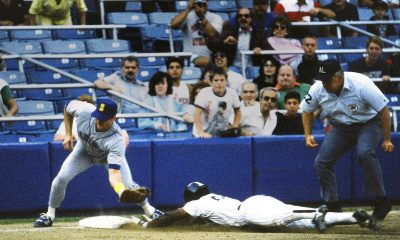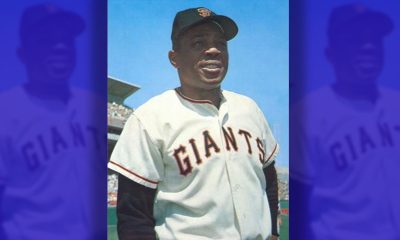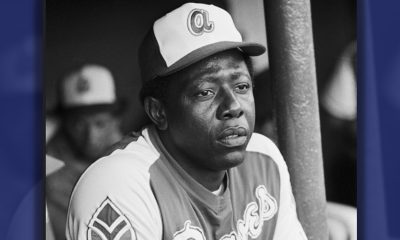Sports
Johnson, Martinez, Smoltz, Biggio Elected to Hall of Fame

From left are Arizona Diamondbacks’ Randy Johnson in 2008, Boston Red Sox’ Pedro Martinez in 2003 and Atlanta Braves’ John Smoltz in 2008. Randy Johnson, Pedro Martinez and John Smoltz are the leading newcomers on baseball’s Hall of Fame ballot when voting is announced Tuesday, Jan. 6, 2014. (AP Photo/File)
RONALD BLUM, AP Sports Writer
NEW YORK (AP) — Randy Johnson, Pedro Martinez and John Smoltz, a trio of star pitchers who dominated in an era of offense, were elected to baseball’s Hall of Fame on Tuesday along with Craig Biggio, the first time since 1955 writers selected four players in one year.
The Big Unit, Martinez and Smoltz easily earned induction on their first tries, and Biggio made it on the third attempt after falling two votes shy last year. Steroids-tainted stars Roger Clemens, Barry Bonds, Mark McGwire and Sammy Sosa remained far from election.
“I realize the cloud has covered a multitude of so many different people, and I realize that the media and people have a hard time distinguishing and determining,” Smoltz said.
Johnson, a five-time Cy Young Award winner with 303 victories and 4,875 strikeouts, was selected on 534 of 549 ballots by veteran members of the Baseball Writers’ Association of America.
“The Hall of Fame was never something that I surely ever thought about,” said Johnson, who has been pursuing a photography career since his retirement.
The left-hander’s 97.3 percentage was the eighth-highest in the history of voting.
“I don’t think people quite understand how difficult it is to be 6-foot-10 and be throwing a ball 60 feet, 6 inches away,” Johnson said. “In order to do that, you have to consistent with your release point and where you’re landing and your arm slot and all that. For someone 6-1, 6-2, there’s less body to keep under control, so it’s a lot easier.”
Martinez, a three-time Cy Young winner with flamboyance to go along with his fastball, appeared on 500 ballots (91.1 percent). Martinez was 219-100, struck out 3,154, led the major leagues in ERA five times and in 2004 helped the Boston Red Sox to their first World Series title in 86 years.
Eleven inches shorter than Johnson, Martinez pitched with exceptional intensity.
“My body would change half an hour before the game, and I would just become this serious, focused person because my dad reminded me you’ve got to be serious about your job,” Martinez recalled. “I saw everybody as an enemy, and I saw everybody as like in a jungle: You just kill to survive. And that’s the intensity and the focus I had to keep to do it every day on a day-to-day basis. And that’s the kind of chip on the shoulder that people thought I had, even though that was my way to concentrate and do the day to day things that I did in baseball.”
Smoltz was picked on 455 ballots (82.9 percent) and will join former Atlanta teammates Greg Maddux and Tom Glavine, who were inducted last summer along with Chicago White Sox slugger Frank Thomas. Smoltz, the 1996 NL Cy Young winner, was 213-155 with 154 saves, the only pitcher with 200 wins and 150 saves. He went 15-4 in the postseason.
Biggio appeared on 454 ballots, 42 more than the 75 percent needed and up from 68.2 percent in his first appearance and 74.8 percent last year. A catcher who shifted to second base and spent three seasons in the outfielder, he had 3,060 hits and 668 doubles in 20 big league seasons, all with the Houston Astros.
The quartet will be inducted in Cooperstown on July 26. The BBWAA had not voted in four players together since selecting Joe DiMaggio, Gabby Hartnett, Ted Lyons and Dazzy Vance 60 years earlier.
Mike Piazza fell 28 votes short but increased his percentage to 69.9 from 57.8 in 2013 and 62.2 last year.
Clemens received 37.5 percent and Bonds 36.8 percent. Clemens, the only seven-time Cy Young winner, started at 37.6 percent in 2013 and dropped to 35.4 last year; Bonds, the only seven-time MVP, began at 36.2 and fell to 34.7.
McGwire, in his ninth and next-to-last year of eligibility, received 10 percent, down from 11 last year and less than half his peak of 23.6 percent in 2008. Sosa was on 6.6 percent of the ballot, down from 12.5 in 2013 and 7.2 last year but above the 5 percent threshold for remaining on next year’s list.
Jeff Bagwell was at 55.7 percent, followed by Tim Raines at 55 percent and Curt Schilling at 39.2 percent. Other players included Lee Smith (30.2), Edgar Martinez (27), Alan Trammell (25.1) and Mike Mussina (24.6).
Don Mattingly received 9.1 percent in his 15th and final appearance on the ballot. Under a change made by the Hall’s board last summer, players’ eligibility was cut from 15 years to 10 but the 11-15 group was grandfathered.
Gary Sheffield (11.7 percent) and Nomar Garciaparra (5.5) will remain on the ballot. Among the 17 first-time eligibles who will be dropped are Carlos Delgado (3.8 percent) and players’ association head Tony Clark, who did not get any votes.
Ken Griffey Jr., Trevor Hoffman and Billy Wagner are among the players eligible for the first time in next year’s ballot.
Copyright 2015 The Associated Press. All rights reserved. This material may not be published, broadcast, rewritten or redistributed.
Alameda County
Seth Curry Makes Impressive Debut with the Golden State Warriors
Seth looked comfortable in his new uniform, seamlessly fitting into the Warriors’ offensive and defensive system. He finished the night with an impressive 14 points, becoming one of the team’s top scorers for the game. Seth’s points came in a variety of ways – floaters, spot-up three-pointers, mid-range jumpers, and a handful of aggressive drives that kept the Oklahoma City Thunder defense on its heels.

By Y’Anad Burrell
Tuesday night was anything but ordinary for fans in San Francisco as Seth Curry made his highly anticipated debut as a new member of the Golden State Warriors. Seth didn’t disappoint, delivering a performance that not only showcased his scoring ability but also demonstrated his added value to the team.
At 35, the 12-year NBA veteran on Monday signed a contract to play with the Warriors for the rest of the season.
Seth looked comfortable in his new uniform, seamlessly fitting into the Warriors’ offensive and defensive system. He finished the night with an impressive 14 points, becoming one of the team’s top scorers for the game. Seth’s points came in a variety of ways – floaters, spot-up three-pointers, mid-range jumpers, and a handful of aggressive drives that kept the Oklahoma City Thunder defense on its heels.
One of the most memorable moments of the evening came before Seth even scored his first points. As he checked into the game, the Chase Center erupted into applause, with fans rising to their feet to give the newest Warrior a standing ovation.
The crowd’s reaction was a testament not only to Seth’s reputation as a sharpshooter but also to the excitement he brings to the Warriors. It was clear that fans quickly embraced Seth as one of their own, eager to see what he could bring to the team’s championship aspirations.
Warriors’ superstar Steph Curry – Seth’s brother – did not play due to an injury. One could only imagine what it would be like if the Curry brothers were on the court together. Magic in the making.
Seth’s debut proved to be a turning point for the Warriors. Not only did he contribute on the scoreboard, but he also brought a sense of confidence and composure to the floor.
While their loss last night, OKC 124 – GSW 112, Seth’s impact was a game-changer and there’s more yet to come. Beyond statistics, it was clear that Seth’s presence elevated the team’s performance, giving the Warriors a new force as they look to make a deep playoff run.
Barbara Lee
WNBA’s Golden State Valkyries Kick Off Season with Community Programs in Oakland
“The Golden State Valkyries are more than a team—they’re a movement,” said Oakland Interim-Mayor Kevin Jenkins. “Their touchdown in Oakland marks a new era of opportunity, inspiration, and equity in sports. This partnership reflects our city’s deep commitment to uplifting women, investing in youth, and building a community where every dream has a place to grow. We’re proud to welcome the Valkyries to The Town.”
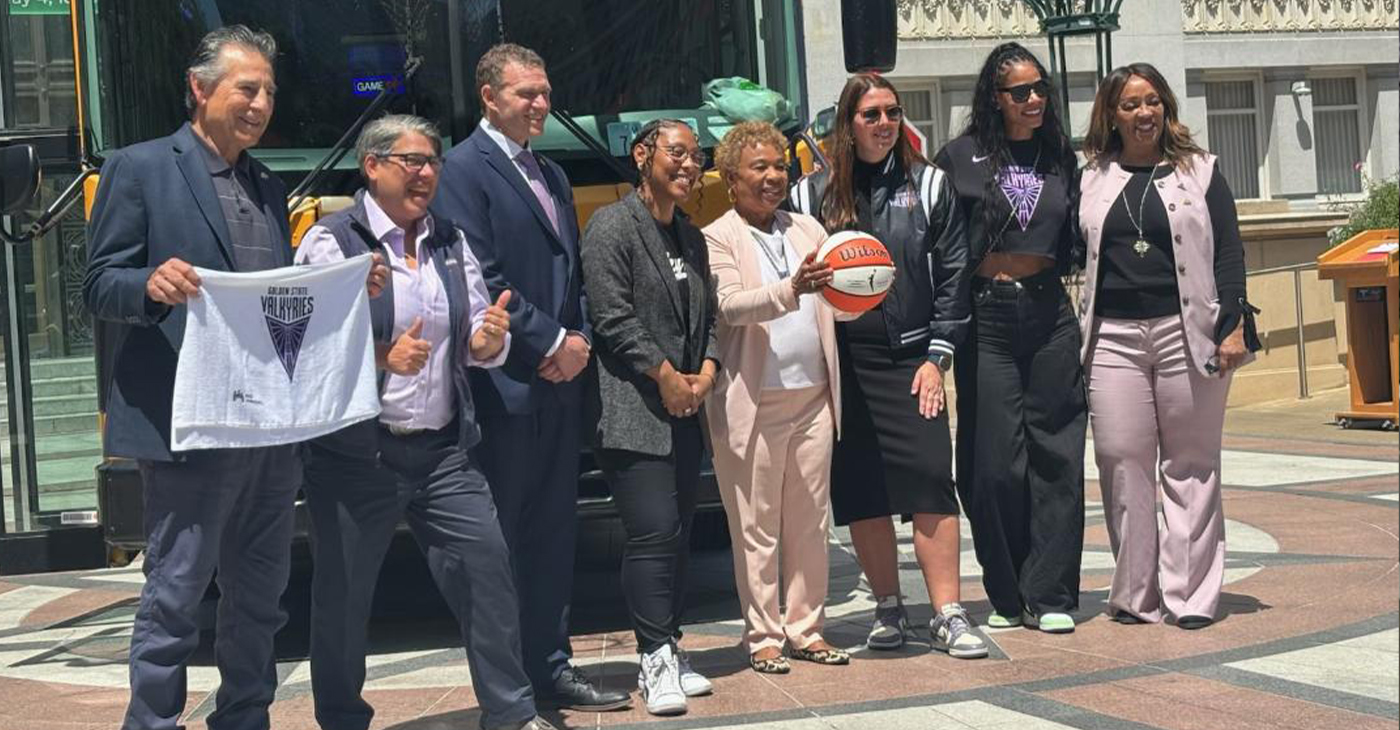
Team installs new nets at playgrounds, holds flag-raisings at City Halls in Oakland and S.F.
Special to The Post
The Golden State Valkyries brought the excitement of their inaugural season to every corner of the Bay Area with a full slate of community celebrations leading up to their historic home-opener against the Los Angeles Sparks at the Chase Center in San Francisco on Friday.
The week featured flag-raising ceremonies at city halls in Oakland and San Francisco, three “Violet Net” installation days at Oakland parks to encourage basketball play, fun “Hoopbus” takeovers at multiple schools presented by Kaiser Permanente, and player appearances.
“The Golden State Valkyries are more than a team—they’re a movement,” said Oakland Interim-Mayor Kevin Jenkins. “Their touchdown in Oakland marks a new era of opportunity, inspiration, and equity in sports. This partnership reflects our city’s deep commitment to uplifting women, investing in youth, and building a community where every dream has a place to grow. We’re proud to welcome the Valkyries to The Town.”
In total, 90 violet nets were installed on 45 basketball courts across 34 public parks throughout Oakland this week. A list of the parks receiving violet nets can be found at Valkyries.com.
About the Golden State Valkyries
The Golden State Valkyries, the WNBA affiliate of the seven-time NBA Champion Golden State Warriors, were announced as the 13th WNBA franchise on Oct. 5, 2023. According to Norse mythology, Valkyries are a host of warrior women who are fearless and unwavering – flying through air and sea alike.
This brand is Golden State’s modern interpretation of Valkyries: strong, bold, and fierce. Tipping off during the 2025 WNBA season, the team is headquartered in Oakland and will play home games at Chase Center in San Francisco. For Golden State Valkyries’ assets, including team logos, visit valkyries.com.
Activism
McClymonds High Names School Gym for Star Graduate, Basketball Legend Bill Russell
William “Bill” Felton Russell was born on Feb. 12, 1934, and died on July 31, 2022. He achieved fame as a U.S. professional basketball player who played center for the Boston Celtics of the National Basketball Association (NBA) from 1956 to 1969. He was the centerpiece of the Celtics dynasty that won 11 NBA championships during his 13-year career.
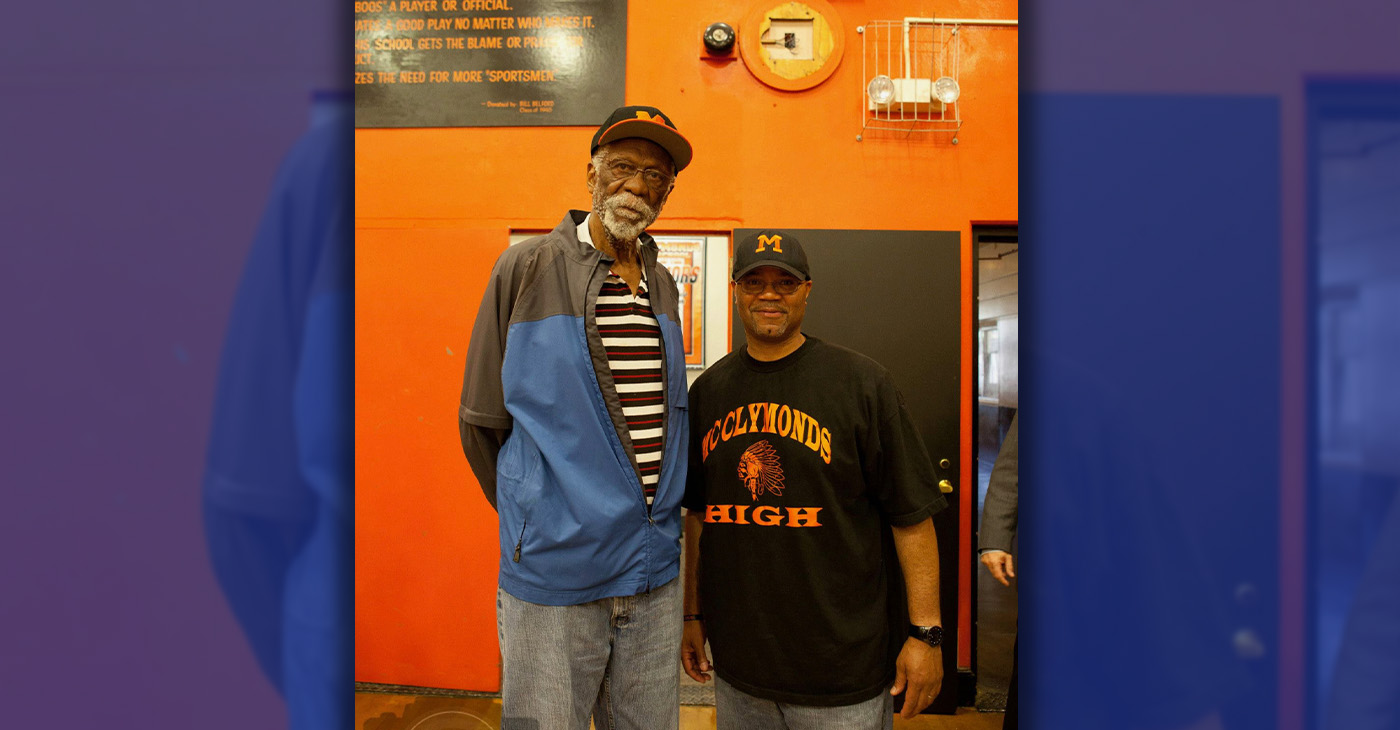
By Ken Epstein
West Oakland’s McClymonds High School, “the School of Champions,” this week named the school’s gymnasium in honor of one of its most famous graduates, basketball legend Bill Russell (class of ’52).
William “Bill” Felton Russell was born on Feb. 12, 1934, and died on July 31, 2022. He achieved fame as a U.S. professional basketball player who played center for the Boston Celtics of the National Basketball Association (NBA) from 1956 to 1969. He was the centerpiece of the Celtics dynasty that won 11 NBA championships during his 13-year career.
Russell is widely known as one of the greatest basketball players of all time. In 2011, he received the Presidential Medal of Freedom, the country’s highest civil honor, from President Barack Obama for Russell’s contributions to basketball and the Civil Rights Movement.
The McClymonds’ naming ceremony was held on Wednesday, the same day as Russell’s birthday. Oakland leader Bill Patterson, a longtime friend of Russell’s, was scheduled to cut the ribbon at the reopening of the gym, which had been closed for several months for renovation. Russell’s daughter Karen was scheduled to attend the ribbon cutting.
Russell’s name and signature are now printed on the gymnasium floor.
Patterson was working at DeFremery Park when he met Russell. “I befriended him as a boy and during his years at University of San Francisco” said Patterson. “We stayed friends for the rest of his life.”
Said McClymonds Principal Darielle Davis, herself a McClymonds graduate, “We are excited to honor Bill Russell for his sports accolades and because he broke color barriers. He is part of our legacy, and legacy is really important at McClymonds.”
Brian McGhee, community schools manager at McClymonds and former football player at UC Berkeley, said that Russell meant a lot to him and others at the school. “He was a beacon of light and hope for West Oakland,” he said. “He did a lot for sports and for civil rights.”
Starting in 2018, Ben “Coach” Tapscott worked with Patterson and other McClymonds grads, community members, and former coaches to encourage the Oakland Board of Education to endorse the naming of the school gym, which finally happened recently.
“We worked hard to make this happen,” said Tapscott. “He’s an important part of McClymond’s history, along with a lot of other famous graduates,” he said.
-

 Activism4 weeks ago
Activism4 weeks agoOakland Post: Week of November 12 – 18, 2025
-

 Activism3 weeks ago
Activism3 weeks agoIN MEMORIAM: William ‘Bill’ Patterson, 94
-

 Activism4 weeks ago
Activism4 weeks agoHow Charles R. Drew University Navigated More Than $20 Million in Fed Cuts – Still Prioritizing Students and Community Health
-

 Bay Area4 weeks ago
Bay Area4 weeks agoNo Justice in the Justice System
-

 #NNPA BlackPress3 weeks ago
#NNPA BlackPress3 weeks agoLewis Hamilton set to start LAST in Saturday Night’s Las Vegas Grand Prix
-

 #NNPA BlackPress3 weeks ago
#NNPA BlackPress3 weeks agoBeyoncé and Jay-Z make rare public appearance with Lewis Hamilton at Las Vegas Grand Prix
-

 Activism2 weeks ago
Activism2 weeks agoOakland Post: Week of November 19 – 25, 2025
-

 #NNPA BlackPress4 weeks ago
#NNPA BlackPress4 weeks agoThe Perfumed Hand of Hypocrisy: Trump Hosted Former Terror Suspect While America Condemns a Muslim Mayor

